CD8+CD45RA+CCR7+FOXP3+ T cells with immunosuppressive properties: a novel subset of inducible human regulatory T cells
- PMID: 22821963
- PMCID: PMC3424334
- DOI: 10.4049/jimmunol.1200122
CD8+CD45RA+CCR7+FOXP3+ T cells with immunosuppressive properties: a novel subset of inducible human regulatory T cells
Abstract
CD8 T cells stimulated with a suboptimal dose of anti-CD3 Abs (100 pg/ml) in the presence of IL-15 retain a naive phenotype with expression of CD45RA, CD28, CD27, and CCR7 but acquire new functions and differentiate into immunosuppressive T cells. CD8+CCR7+ regulatory T cells (Tregs) express FOXP3 and prevent CD4 T cells from responding to TCR stimulation and entering the cell cycle. Naive CD4 T cells are more susceptible to inhibition than memory cells. The suppressive activity of CD8+CCR7+ Tregs is not mediated by IL-10, TGF-β, CTLA-4, CCL4, or adenosine and relies on interference with very early steps of the TCR signaling cascade. Specifically, CD8+CCR7+ Tregs prevent TCR-induced phosphorylation of ZAP70 and dampen the rise of intracellular calcium in CD4 T cells. The inducibility of CD8+CCR7+ Tregs is correlated with the age of the individual with PBLs of donors older than 60 y yielding low numbers of FOXP3(low) CD8 Tregs. Loss of CD8+CCR7+ Tregs in the elderly host may be of relevance in the aging immune system as immunosenescence is associated with a state of chronic smoldering inflammation.
Conflict of interest statement
The authors have no financial conflicts of interest.
Figures


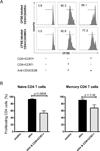
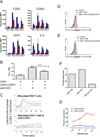
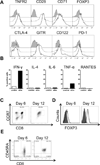
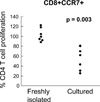
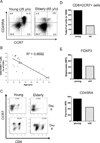

Similar articles
-
Only the CD45RA+ subpopulation of CD4+CD25high T cells gives rise to homogeneous regulatory T-cell lines upon in vitro expansion.Blood. 2006 Dec 15;108(13):4260-7. doi: 10.1182/blood-2006-06-027409. Epub 2006 Aug 17. Blood. 2006. PMID: 16917003 Clinical Trial.
-
CD8+ Foxp3+ regulatory T cells are induced during graft-versus-host disease and mitigate disease severity.J Immunol. 2012 Jul 1;189(1):464-74. doi: 10.4049/jimmunol.1200886. Epub 2012 May 30. J Immunol. 2012. PMID: 22649199 Free PMC article.
-
Increased tumor-infiltrating CD45RA-CCR7- regulatory T-cell subset with immunosuppressive properties foster gastric cancer progress.Cell Death Dis. 2017 Aug 17;8(8):e3002. doi: 10.1038/cddis.2017.388. Cell Death Dis. 2017. PMID: 28817117 Free PMC article.
-
TH2 cells in the pathogenesis of airway remodeling: regulatory T cells a plausible panacea for asthma.Immunol Res. 2006;35(3):219-32. doi: 10.1385/IR:35:3:219. Immunol Res. 2006. PMID: 17172648 Review.
-
Regulatory T cells and the immune aging process: a mini-review.Gerontology. 2014;60(2):130-7. doi: 10.1159/000355303. Epub 2013 Nov 28. Gerontology. 2014. PMID: 24296590 Free PMC article. Review.
Cited by
-
NADPH oxidase deficiency underlies dysfunction of aged CD8+ Tregs.J Clin Invest. 2016 May 2;126(5):1953-67. doi: 10.1172/JCI84181. Epub 2016 Apr 18. J Clin Invest. 2016. PMID: 27088800 Free PMC article.
-
Clinical significance of CCR7+CD8+ T cells in kidney transplant recipients with allograft rejection.Sci Rep. 2018 Jun 11;8(1):8827. doi: 10.1038/s41598-018-27141-6. Sci Rep. 2018. PMID: 29891963 Free PMC article.
-
Newly Found Peacekeeper: Potential of CD8+ Tregs for Graft-Versus-Host Disease.Front Immunol. 2021 Nov 24;12:764786. doi: 10.3389/fimmu.2021.764786. eCollection 2021. Front Immunol. 2021. PMID: 34899714 Free PMC article. Review.
-
Central memory CD8+ T lymphocytes mediate lung allograft acceptance.J Clin Invest. 2014 Mar;124(3):1130-43. doi: 10.1172/JCI71359. Epub 2014 Feb 24. J Clin Invest. 2014. PMID: 24569377 Free PMC article.
-
Therapeutic polyclonal human CD8+ CD25+ Fox3+ TNFR2+ PD-L1+ regulatory cells induced ex-vivo.Clin Immunol. 2013 Dec;149(3):450-63. doi: 10.1016/j.clim.2013.08.007. Epub 2013 Aug 20. Clin Immunol. 2013. PMID: 24211847 Free PMC article.
References
-
- Sakaguchi S, Yamaguchi T, Nomura T, Ono M. Regulatory T cells and immune tolerance. Cell. 2008;133:775–787. - PubMed
-
- Belkaid Y, Tarbell K. Regulatory T cells in the control of host-microorganism interactions (*) Annu Rev Immunol. 2009;27:551–589. - PubMed
-
- Zheng Y, Rudensky AY. Foxp3 in control of the regulatory T cell lineage. Nat Immunol. 2007;8:457–462. - PubMed
-
- Ziegler SF. FOXP3: of mice and men. Annu Rev Immunol. 2006;24:209–226. - PubMed
-
- Wang J, Ioan-Facsinay A, van der Voort EI, Huizinga TW, Toes RE. Transient expression of FOXP3 in human activated nonregulatory CD4+ T cells. Eur J Immunol. 2007;37:129–138. - PubMed
Publication types
MeSH terms
Substances
Grants and funding
- AR 42527/AR/NIAMS NIH HHS/United States
- EY 11916/EY/NEI NIH HHS/United States
- AI 90019/AI/NIAID NIH HHS/United States
- R01 AI044142/AI/NIAID NIH HHS/United States
- P01 HL058000/HL/NHLBI NIH HHS/United States
- U19 AI090019/AI/NIAID NIH HHS/United States
- HL 58000/HL/NHLBI NIH HHS/United States
- R56 AI044142/AI/NIAID NIH HHS/United States
- R01 EY011916/EY/NEI NIH HHS/United States
- AI 57266/AI/NIAID NIH HHS/United States
- AI 44142/AI/NIAID NIH HHS/United States
- U19 AI057266/AI/NIAID NIH HHS/United States
- R01 AR042527/AR/NIAMS NIH HHS/United States
LinkOut - more resources
Full Text Sources
Other Literature Sources
Research Materials

